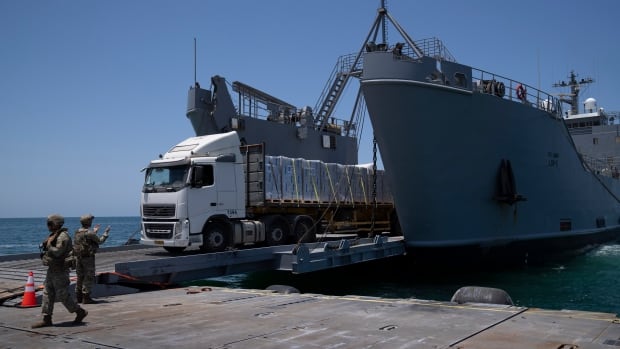The pier built by the U.S. military to bring humanitarian aid to Gaza will be reinstalled Wednesday to be used for several days, but then the plan is to pull it out permanently, several U.S. officials said. It would deal the final blow to a project long plagued by bad weather, security uncertainties and difficulties getting food into the hands of starving Palestinians.
The officials said the goal is to clear whatever aid has piled up in Cyprus and on the floating dock offshore and get it to the secure area on the beach in Gaza. Once that has been done, the army will dismantle the pier and depart. The officials spoke on condition of anonymity because final details are still being worked out.
Officials had hoped the pier would provide a critical flow of aid to starving residents in Gaza as the nine-month-long war drags on. But while more than 8.6 million kilograms of food has gotten into Gaza via the pier, the project has been hampered by persistent heavy seas and stalled deliveries due to ongoing security threats as Israeli troops continue their offensive against Hamas in Gaza.
The decision to pull out the pier comes as Israeli troops make another push deeper into Gaza City, which Hamas says could threaten long-running negotiations over a ceasefire and hostage release, after the two sides appeared to have narrowed the gaps in recent days.
Airstrikes kill 20: hospital authorities
Israeli airstrikes early Wednesday killed 20 Palestinians in central Gaza, including six children and three women, some of them inside a purported “safe zone” declared by the Israeli military, hospital authorities said.
This second straight night of deadly strikes in the central town of Deir al-Balah and nearby refugee camps came as U.S., Egyptian and Qatari mediators as well as Israeli officials came together in the Qatari capital, Doha, for talks trying to push through a long-elusive deal for a ceasefire and hostage release.

Strikes early Wednesday hit three houses in the Nuseirat refugee camp, killing 12 people including five children, said authorities at al-Aqsa Martyrs Hospital, where the casualties were taken. An Associated Press reporter counted the bodies.
The camp, like others around Gaza, was originally erected to house Palestinians driven from their homes during the 1948 war surrounding Israel’s creation. It has grown into an urban neighbourhood in the decades since.
A fourth strike early Wednesday killed four men, three women and a child when it hit a home in Deir al-Balah, an area that is located within the “humanitarian safe zone” where Israel has told Palestinians to seek refuge as it conducts offensives in multiple parts of the Gaza Strip.
Umm Ali, one of the people who was on the move over the weekend, said leaflets were dropped in parts of Gaza City on Sunday morning, asking people to leave the area immediately. She — and many others — fled, but she had no sense of where she could go to find safety.
The overnight bombardment came hours after Israeli warplanes struck the entrance of a school sheltering displaced families outside the southern city of Khan Younis.
The toll from the strike rose to 31 people killed, including eight children, and more than 50 wounded, officials at the nearby Nasser Hospital said Wednesday.
UN suspended deliveries in June
U.S. troops removed the pier on June 28 because of bad weather and moved it to the port of Ashdod in Israel. But distribution of the aid had already stopped due to the security concerns.
The United Nations suspended deliveries from the pier on June 9, a day after the Israeli military used the area around it for airlifts after a hostage rescue that killed more than 270 Palestinians. U.S. and Israeli officials said no part of the pier itself was used in the raid, but UN officials said any perception in Gaza that the project was used may endanger their aid work.
As a result, aid brought through the pier into the secure area on the beach piled up for days while talks continued between the UN and Israel. More recently, the World Food Program hired a contractor to move the aid from the beach to prevent the food and other supplies from spoiling.
The Pentagon said all along that the pier was only a temporary project, designed to prod Israel into opening and allowing aid to flow better through land routes — which are far more productive than the U.S.-led sea route.
And the weather now is projected only to get worse.
The pier was damaged by high winds and heavy seas on May 25, just a bit more than a week after it began operating, and was removed for repairs. It was reconnected on June 7, but removed again due to bad weather on June 14. It was put back days later, but heavy seas again forced its removal on June 28.
A new temporary pier built by the U.S. is helping bring desperately needed aid to Gaza. The first shipment of humanitarian aid has already started rolling into the besieged enclave, but UN officials say it’s no replacement for deliveries by land.








